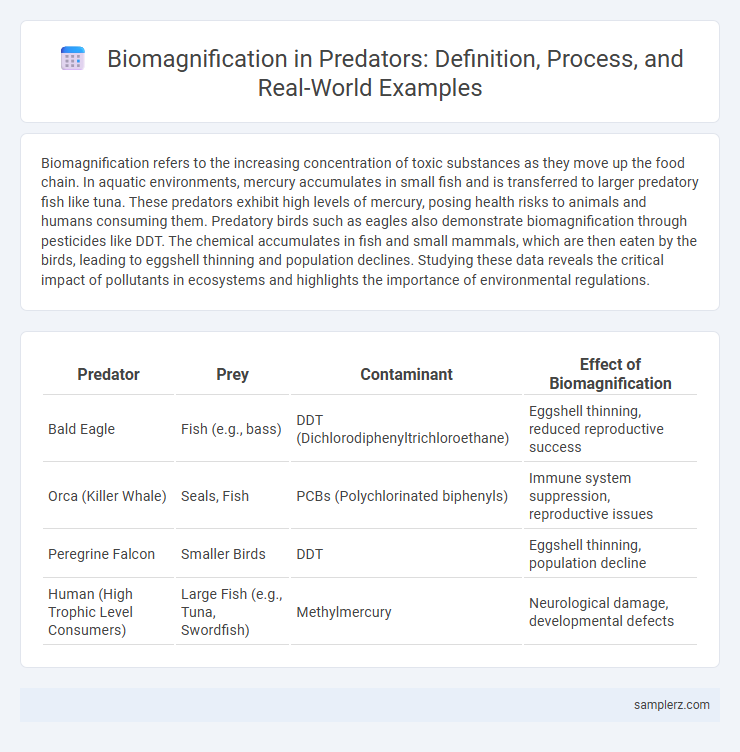Biomagnification refers to the increasing concentration of toxic substances as they move up the food chain. In aquatic environments, mercury accumulates in small fish and is transferred to larger predatory fish like tuna. These predators exhibit high levels of mercury, posing health risks to animals and humans consuming them. Predatory birds such as eagles also demonstrate biomagnification through pesticides like DDT. The chemical accumulates in fish and small mammals, which are then eaten by the birds, leading to eggshell thinning and population declines. Studying these data reveals the critical impact of pollutants in ecosystems and highlights the importance of environmental regulations.
Table of Comparison
| Predator | Prey | Contaminant | Effect of Biomagnification |
|---|---|---|---|
| Bald Eagle | Fish (e.g., bass) | DDT (Dichlorodiphenyltrichloroethane) | Eggshell thinning, reduced reproductive success |
| Orca (Killer Whale) | Seals, Fish | PCBs (Polychlorinated biphenyls) | Immune system suppression, reproductive issues |
| Peregrine Falcon | Smaller Birds | DDT | Eggshell thinning, population decline |
| Human (High Trophic Level Consumers) | Large Fish (e.g., Tuna, Swordfish) | Methylmercury | Neurological damage, developmental defects |
Overview of Biomagnification in Predator Species
Biomagnification occurs when predator species accumulate higher concentrations of toxins, such as mercury or DDT, by consuming contaminated prey. Top predators like eagles, sharks, and orcas exhibit elevated levels of persistent organic pollutants, which can impair reproduction and immune function. This process highlights the critical impact of pollution on food webs and ecosystem health.
Case Study: DDT Biomagnification in Birds of Prey
DDT accumulates through trophic levels, causing severe biomagnification in birds of prey such as eagles and falcons. These predators ingest contaminated prey, leading to high DDT concentrations that disrupt calcium metabolism and result in eggshell thinning. The decline in reproductive success caused by biomagnification of DDT exemplifies its profound ecological impact on top predators.
Mercury Accumulation in Marine Predators
Marine predators such as sharks and swordfish exhibit significant mercury accumulation due to biomagnification, where mercury concentrations increase up the food chain from contaminated plankton and small fish. Studies show that mercury levels in these predators can exceed safe consumption limits, posing health risks to humans and wildlife. This process highlights the critical impact of industrial mercury pollution on marine ecosystems and the need for stringent environmental regulations.
PCBs and Their Impact on Polar Bears
Polychlorinated biphenyls (PCBs) accumulate in Arctic marine food webs, leading to biomagnification in top predators like polar bears. These toxic compounds concentrate in polar bears' fat tissues, causing immune system suppression and reproductive issues. Studies reveal PCB levels in polar bears are among the highest recorded, highlighting severe ecological and health risks linked to persistent organic pollutants.
Heavy Metal Biomagnification in Aquatic Food Chains
Heavy metal biomagnification occurs when pollutants like mercury and lead accumulate in aquatic organisms and intensify through successive trophic levels, particularly in predators such as large fish and birds. Predatory species at the top of aquatic food chains can exhibit mercury concentrations millions of times higher than those in surrounding water due to biomagnification. This process poses severe health risks to wildlife and humans consuming these contaminated predators, highlighting the critical need for monitoring and regulating heavy metal pollution in aquatic environments.
Persistent Organic Pollutants in Top Predators
Persistent Organic Pollutants (POPs) accumulate in the fatty tissues of top predators, such as polar bears and orcas, through the process of biomagnification. These toxic chemicals increase in concentration at each trophic level, posing severe health risks including reproductive failure and immune system suppression. The persistence and bioaccumulation of POPs in apex predators highlight the critical need for global regulation and monitoring to protect vulnerable ecosystems.
Biomagnification Effects on Apex Predator Health
Biomagnification causes toxic substances like mercury and polychlorinated biphenyls (PCBs) to accumulate in apex predators such as orcas, leading to reproductive failures, immune system suppression, and neurological damage. These contaminants increase in concentration up the food chain, resulting in higher toxin levels in predators than in their prey. The health impact on apex predators disrupts ecosystem balance and threatens biodiversity due to decreased survival and reproductive rates.
Long-Term Consequences for Predator Populations
Biomagnification causes persistent organic pollutants like mercury and PCBs to accumulate in apex predators such as eagles and orcas, leading to reproductive failures and immune system suppression. Over time, the decline in predator populations disrupts ecosystem stability and reduces biodiversity. Long-term exposure to these toxins results in decreased survival rates and altered predator-prey dynamics.
Mitigating Biomagnification in Wildlife Ecosystems
Persistent organic pollutants like mercury accumulate in aquatic food chains, leading to biomagnification in top predators such as large fish and birds of prey. Mitigating biomagnification involves reducing pollutant emissions, enforcing stricter environmental regulations, and restoring contaminated habitats to break the pollutant transmission cycle. Monitoring sentinel species and promoting sustainable land-use practices also help protect wildlife ecosystems from toxic accumulations.
Human Implications from Consuming Affected Predators
Biomagnification causes toxic substances like mercury and PCBs to accumulate in top predators such as large fish and marine mammals, which humans often consume. This leads to serious health risks including neurological damage, developmental delays in children, and increased cancer risk. Monitoring pollutant levels in seafood is critical to protecting public health and ensuring safe dietary choices.

example of biomagnification in predator Infographic
 samplerz.com
samplerz.com